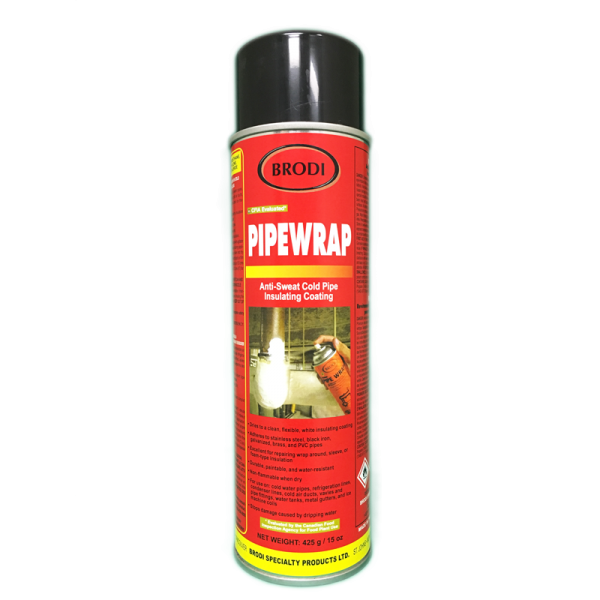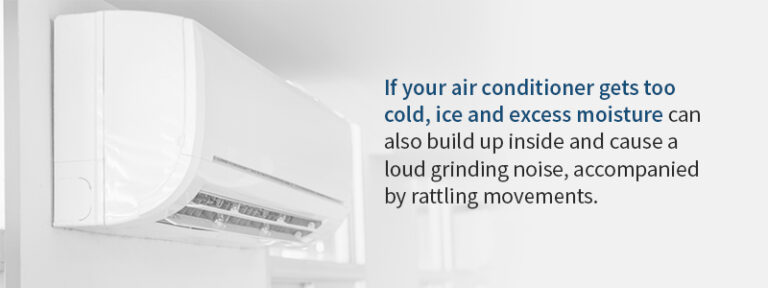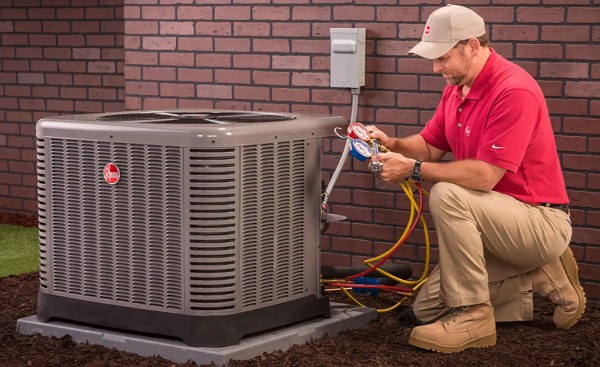How Do I Stop My AC Pipe From Sweating: Proven Solutions
To stop your AC pipe from sweating, insulate the pipe with foam insulation. Ensure the insulation is properly sealed.
Sweating AC pipes are a common issue, especially in humid environments. This condensation can lead to water damage and mold growth if not addressed promptly. Insulating the pipe helps to maintain a consistent temperature, preventing moisture from forming on its surface.
Use foam insulation for its effectiveness and ease of installation. Seal the insulation tightly to avoid any gaps where air might seep through. Regularly check the insulation for wear and tear, replacing it as needed to ensure optimal performance. By taking these steps, you can protect your home from potential water damage and maintain a more efficient cooling system.

Credit: www.youtube.com
Causes Of Ac Pipe Sweating
AC pipe sweating is a common issue in many homes. It happens when moisture forms on the outside of the pipes. Understanding the causes can help you fix it. Below are some key reasons for this problem.
Condensation Basics
Condensation occurs when warm air meets a cold surface. The moisture in the air turns into water droplets. This is why you see water on your AC pipes. It’s the same reason your cold drink sweats on a hot day.
The amount of moisture in the air affects condensation. High humidity means more moisture. This makes it easier for water to form on cold surfaces. Proper ventilation can help reduce humidity.
Temperature Differences
Temperature differences play a big role in AC pipe sweating. When there is a big gap between the room temperature and the pipe’s temperature, condensation forms. Cold pipes in warm rooms sweat more.
Insulating your AC pipes can help. Pipe insulation keeps the cold air inside the pipes. This reduces the temperature difference and helps stop sweating. Foam pipe sleeves are a good option for insulation.

Credit: www.reddit.com
Identifying The Problem
Before you can stop your AC pipe from sweating, you need to identify the problem. Understanding the signs of sweating pipes and the potential damage they can cause is crucial. This section will help you recognize and address these issues.
Signs Of Sweating Pipes
- Water droplets forming on the outside of pipes.
- Puddles of water near your AC unit.
- Damp spots on walls or ceilings.
- Musty odors around the AC unit.
- Mold growth near the pipes.
Potential Damage
Sweating pipes can lead to significant damage. Here are some potential issues:
| Damage Type | Description |
|---|---|
| Water Damage | Water can seep into walls and floors, causing rot. |
| Mold Growth | Mold can develop, posing health risks. |
| Structural Issues | Prolonged moisture can weaken structural elements. |
Identifying these signs early can save you from costly repairs. Regular checks on your AC pipes can prevent severe damage. Stay vigilant and address any signs of sweating pipes promptly.
Insulation Options
Air conditioner pipes often sweat due to condensation. Proper insulation can prevent this. Here are some insulation options to stop your AC pipe from sweating.
Foam Insulation
Foam insulation is a popular choice. It’s easy to install and effective.
- Benefits:
- Lightweight
- Cost-effective
- Good thermal resistance
- Installation Steps:
- Measure the pipe’s length.
- Cut the foam to fit the pipe.
- Wrap the foam around the pipe.
- Secure with tape or adhesive.
Rubber Insulation
Rubber insulation is another great option. It’s durable and flexible.
- Benefits:
- High durability
- Good flexibility
- Moisture resistant
- Installation Steps:
- Measure the pipe’s length.
- Cut the rubber to fit the pipe.
- Wrap the rubber around the pipe.
- Secure with tape or adhesive.
Both foam and rubber insulation can help stop your AC pipe from sweating. Choose the option that best suits your needs.
Proper Installation Techniques
Proper installation techniques are key to preventing your AC pipe from sweating. Correctly securing the insulation and avoiding gaps can make a significant difference.
Securing The Insulation
Secure the insulation tightly around the AC pipes. Use strong, durable materials. Make sure the insulation covers the entire pipe. This prevents warm air from touching the cold pipe. Use zip ties or duct tape to keep the insulation in place.
| Materials | Usage |
|---|---|
| Foam Insulation | Covers the pipes |
| Zip Ties | Secures the insulation |
| Duct Tape | Seals the insulation |
Avoiding Gaps
Ensure there are no gaps in the insulation. Even small gaps can cause sweating. Overlap the insulation at the joints. Cover any exposed areas with additional insulation. Use sealants or tape to close any openings.
- Inspect the insulation for gaps
- Overlap insulation at joints
- Use sealant for small gaps
Preventing gaps helps in stopping condensation. It keeps the cold air in and the warm air out.
Humidity Control
Controlling humidity is crucial to stop your AC pipe from sweating. High humidity levels can cause condensation, leading to moisture buildup on the pipes. Managing the indoor humidity can effectively reduce this problem. Here are some methods to control humidity.
Using Dehumidifiers
Dehumidifiers can help reduce humidity in your home. They remove excess moisture from the air. Place a dehumidifier near the AC unit. This can prevent the pipes from sweating. Choose a dehumidifier with an auto-drain feature. This will ensure continuous operation without frequent emptying.
- Place dehumidifiers in humid rooms.
- Set humidity levels between 30-50%.
- Regularly clean the dehumidifier filters.
Ventilation Improvements
Improving ventilation can also help control humidity. Good airflow reduces moisture buildup. Install exhaust fans in kitchens and bathrooms. These areas often have high humidity. Ensure your home has proper attic ventilation. This prevents moisture accumulation.
- Use exhaust fans while cooking or showering.
- Open windows to allow fresh air in.
- Install attic vents to improve airflow.
| Method | Action |
|---|---|
| Dehumidifiers | Reduce indoor humidity by removing moisture from the air. |
| Ventilation | Enhance airflow to reduce moisture buildup. |
By using dehumidifiers and improving ventilation, you can effectively control humidity. This will help stop your AC pipe from sweating and maintain a comfortable home environment.
Regular Maintenance
Regular maintenance is essential to prevent your AC pipe from sweating. By keeping the pipes clean and leak-free, you ensure efficient cooling. This section will cover two crucial aspects: checking for leaks and cleaning the pipes.
Checking For Leaks
First, turn off the AC unit. Next, inspect the pipes for any visible leaks. Use a flashlight to see clearly. Look for wet spots or drips. If you find any, mark them for repair. Leaks can cause condensation, leading to sweating pipes.
A simple way to check for leaks is to use soapy water. Mix soap with water in a spray bottle. Spray this on the pipes. Bubbles will form where there are leaks. Fix these leaks with appropriate sealant or tape. Regularly checking for leaks keeps your AC efficient and dry.
Cleaning The Pipes
Dirty pipes can cause sweating. Clean them regularly to avoid this. Turn off the AC unit before starting. Use a damp cloth to wipe the pipes. For stubborn dirt, use a mild cleaner. Avoid harsh chemicals as they can damage the pipes.
Here is a simple cleaning routine:
- Turn off the AC unit.
- Wipe the pipes with a damp cloth.
- Use mild cleaner for tough dirt.
- Dry the pipes with a clean towel.
Clean pipes improve airflow. This reduces condensation and stops sweating. Make cleaning a regular part of your AC maintenance routine.
Professional Assistance
Sometimes, dealing with a sweating AC pipe requires expert help. If DIY methods don’t work, professional assistance is essential. HVAC technicians possess the skills to fix the problem effectively.
When To Call A Technician
Not all sweating pipes need a technician. Here are signs you should call one:
- Constant Dripping: If the pipe drips all the time.
- Mold Growth: If you see mold near the pipe.
- High Humidity: If the room feels very humid.
- Previous Repairs: If you’ve tried fixes without success.
Cost Considerations
Understanding the cost of professional help is important. Costs can vary based on factors like:
| Service | Average Cost |
|---|---|
| Inspection | $50 – $100 |
| Basic Repair | $100 – $200 |
| Complex Repair | $200 – $500 |
Note: Prices can vary by location and technician experience.
Investing in professional help ensures a lasting solution. It also prevents potential damage to your home.

Credit: www.brodi.com
Preventive Measures
Preventing your AC pipe from sweating is crucial. Sweaty pipes can cause water damage and mold. By taking preventive measures, you can avoid these issues. Below are some effective strategies to keep your AC pipes dry.
Routine Inspections
Regular inspections are essential. Check your AC pipes frequently. Look for any signs of moisture or leaks. Here’s a simple checklist:
- Examine pipes for moisture
- Check for any leaks
- Ensure insulation is intact
Use a flashlight to see better. Inspect both the indoor and outdoor units. If you see any problems, fix them immediately. Regular inspections help catch problems early.
Long-term Solutions
Long-term solutions can prevent future issues. Consider these options:
- Upgrade Insulation: Good insulation keeps pipes dry. Use foam insulation sleeves. They are easy to install and effective.
- Install a Dehumidifier: High humidity can cause sweating. A dehumidifier can reduce moisture levels. Place it near the AC unit for best results.
- Seal Air Leaks: Air leaks can cause condensation. Use caulk or weatherstripping to seal gaps. This helps maintain a stable temperature.
| Solution | Benefits |
|---|---|
| Upgrade Insulation | Prevents moisture buildup |
| Install a Dehumidifier | Reduces humidity levels |
| Seal Air Leaks | Stops air infiltration |
Implementing these solutions can save you money. They also extend the lifespan of your AC unit. Keep your pipes dry and your home safe.
Frequently Asked Questions
How To Keep Ac Pipes From Sweating?
Insulate the AC pipes with foam insulation to prevent sweating. Ensure the insulation is tightly sealed and covers the entire pipe.
Why Is My Ac Line Sweating So Much?
Your AC line sweats due to condensation. Warm air meets the cold line, causing moisture to form. Ensure proper insulation to reduce sweating.
How To Stop An Ac Line From Condensation?
Insulate the AC line to prevent condensation. Ensure proper ventilation and maintain regular maintenance to avoid moisture buildup.
Conclusion
Preventing your AC pipe from sweating is crucial for home comfort. Regular maintenance, insulation, and proper airflow can help. Addressing these issues early ensures efficiency and longevity. Keep your system in top shape to avoid costly repairs. Enjoy a cool, dry home environment all summer long.







